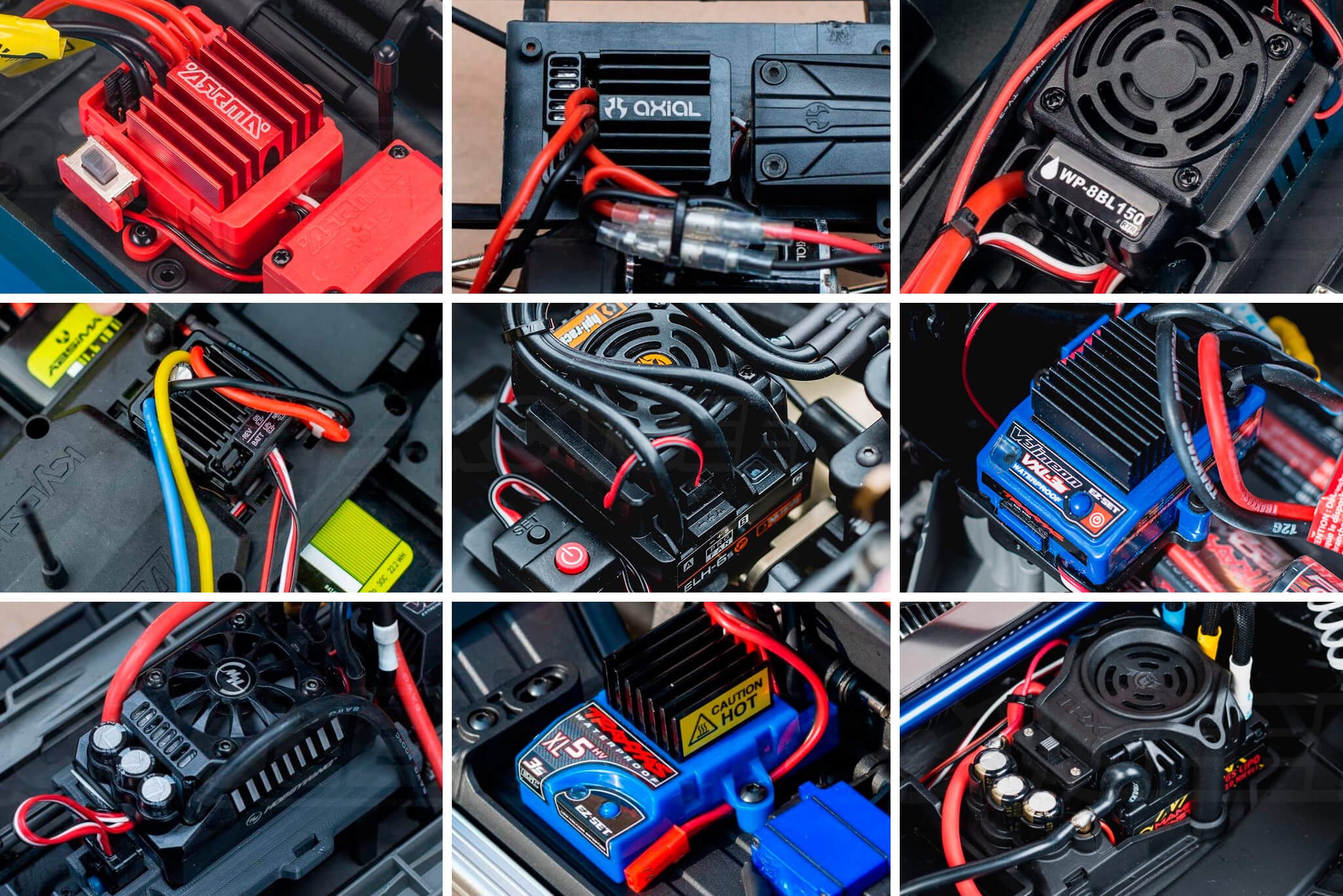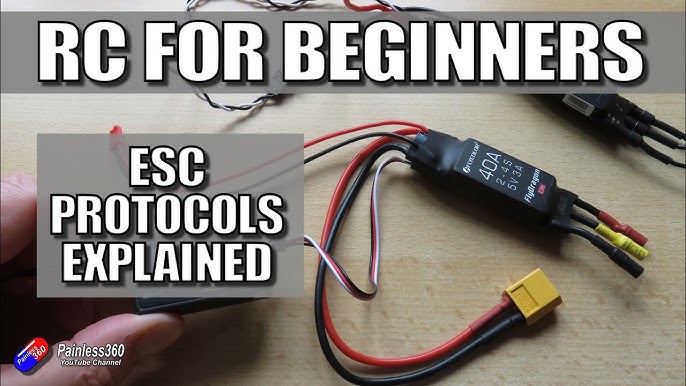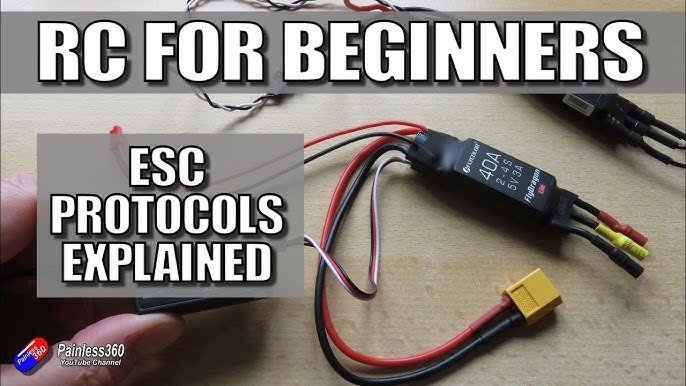Importance of Electronic Speed Controllers in Drones
When you’re piloting a drone, you want a smooth and responsive flight experience. That’s where Electronic Speed Controllers (ESCs) come into play. Imagine them as the brain behind your drone’s throttle. They regulate the speed of the motors, ensuring that the drone reacts swiftly and precisely to your commands. ESCs are crucial because they not only allow for smooth acceleration and deceleration but also help maintain stability during diverse flying conditions. Whether you’re doing aerobatics, capturing stunning aerial photographs, or racing with friends, the ESC makes all the difference. In my early days of flying drones, I remember struggling with inconsistent speed and control, and it turned out my old ESC was the culprit. Once I upgraded to a more reliable ESC, my flying experience transformed completely. Key reasons why ESCs are essential:
- Throttle Control: They provide precise control over the motor speed, allowing for responsive lifting and descending.
- Stability: ESCs work with flight controllers to ensure balanced flight, particularly in windy conditions.
- Efficiency: They optimize power usage, extending battery life and improving overall flight time.
- Safety: ESCs often come equipped with features like thermal protection, preventing motor damage and ensuring safe operations.
Overview of Drone Electronic Speed Controllers
So, what exactly does an electronic speed controller do? An ESC connects between your drone’s motors and the battery, interpreting the signals from your flight controller and adjusting the power sent to each motor accordingly. This allows for smooth transitions during flight— crucial for stability and control. Let’s dive deeper into how these components work together.
- Signal Input: The ESC receives signals from the flight controller, which dictates how fast each motor should spin based on your stick movements.
- Voltage Regulation: The ESC takes the voltage from the battery and splits it among the motors, ensuring each motor receives adequate power to perform as intended.
- PWM (Pulse Width Modulation): Most ESCs use PWM to control the speed of the motors. This method allows the controller to send a signal that controls the throttle with a simple “on” and “off” signal.
- Feedback Loop: After adjusting motor speeds, the ESC monitors motor performance and feeds information back to the flight controller, creating a feedback loop for optimal flying dynamics.
Here’s a breakdown of the common components found in ESCs:
- Microcontroller: The “brain” of the ESC that processes input signals and manages motor speed.
- MOSFETs: These are responsible for switching power to the motors. The efficiency of these components greatly affects how well your drone performs.
- Capacitors: They smooth out the power supply, reducing electrical noise and helping to ensure stability.
- Heat Sink: An essential part for cooling, especially during prolonged or heavy usage.
If you’re new to drones, navigating the world of ESCs can seem daunting, but understanding how they function will empower you when making choices about your drone setup.
Types of ESCs
There are various types of electronic speed controllers available on the market, each suited to different types of drones and flying styles:
- Brushless ESCs: These are widely favored for multi-rotor drones due to their efficiency and performance. They work well with brushless motors, providing excellent speed and responsiveness.
- Brushed ESCs: Commonly used in smaller or less powerful drones, brushed ESCs are generally simpler and less expensive, though they may not offer the same level of performance as brushless options.
Conclusion
Understanding the role of electronic speed controllers in drones is foundational for anyone interested in flying or building drones. The importance of ESCs cannot be overstated; they influence nearly every aspect of your drone’s performance. By investing time in learning about ESCs and their functionalities, you will enhance not only your drone’s flight capabilities but also your overall flying enjoyment. As you continue your drone journey, remember that the right ESC can make a world of difference. Whether you’re aiming for smooth aerial photography or aggressive racing maneuvers, take the time to choose an ESC that suits your needs. Happy flying! 🛩️

Basic Components of Electronic Speed Controllers
Now that you have a grasp on the importance of Electronic Speed Controllers (ESCs) in drones, it’s time to take a closer look at the essential components that make up these vital devices. Each part plays a significant role in ensuring your drone operates smoothly and efficiently. Let’s dive in!
Motor Connectors and Signal Wires
At the heart of any ESC are the motor connectors and signal wires. These components are the lifeline that ensures your motors receive the right signals and power.
- Motor Connectors:
- Functionality: Motor connectors link the ESC directly to the drone’s motors. They complete the circuit, allowing the transfer of electrical power necessary for motor operation.
- Types: Common connector types include bullet connectors, tab connectors, and JST connectors, each designed for different current ratings and sizes. For instance, bullet connectors are robust and facilitative of easy disconnection during repairs or upgrades.
- Considerations: When choosing connectors, it’s essential to ensure they are rated to handle the electrical current your motor requires. Mismatched connectors can lead to overheating and, ultimately, failure.
- Signal Wires:
- Purpose: These wires are responsible for sending signals from the flight controller to the ESC, communicating the required power output for each motor.
- Design: Signal wires are typically thin and insulated to minimize weight, which is crucial for maintaining drone efficiency.
- Connection Types: Most ESCs utilize a three-wire signal connection system that includes positive, negative, and signal wires. This triad helps in ensuring a strong communication link between the ESC and the flight controller.
In my early experiences with drone assembly, I overlooked the quality of connectors and signal wires while building my setup. When my drone experienced inconsistent behavior mid-air, I found that the connectors weren’t securely fitted. A simple upgrade to higher-quality components resolved those intermittent issues, teaching me how crucial these details can be for a smooth flying experience!
Power Input and Output
Power management is another critical aspect of ESCs, and it revolves around how these components handle electricity both entering and leaving the system.
- Power Input:
- Battery Connection: The power input on an ESC connects directly to your drone’s battery. This connection is vital because the ESC needs to draw sufficient power to drive the motors effectively.
- Voltage Ratings: It’s important to note that ESCs are specifically rated for certain voltage levels. Using an ESC rated for a lower voltage than your battery can lead to potential burnouts, so always check compatibility.
- Connector Types: Similar to motor connectors, power inputs can utilize various connection types such as XT60, XT90, or EC3 connectors, each having unique sizes and current handling capabilities.
- Power Output:
- Motor Power Supply: The ESC outputs power to each motor based on the signals received from the flight controller. This coordination is critical; without proper output management, your drone won’t respond correctly, leading to erratic behaviors.
- Current Ratings: Each ESC comes with a specified current rating for output—exceeding this limit can cause overheating or permanent damage. It’s wise to select an ESC that far exceeds the current demands of your motors for added safety and efficiency.
- Back-EMF Protection: Many ESCs are designed with features to protect against back electromotive force (back-EMF), which can occur when the motors decelerate rapidly. This protection helps prevent potential damage to the ESC from excess voltage.
As I delved into the specifics of power management, I couldn’t help but appreciate the integration of these components. The first time I adjusted the power settings on my ESC to better match my battery output, the difference in responsiveness and control was astounding! I realized how a little attention to detail could elevate my drone game.
Conclusion
Understanding the basic components of electronic speed controllers is paramount for any drone enthusiast, whether you’re a beginner or an experienced flyer. The interplay between motor connectors, signal wires, power input, and output ensures that your drone behaves as you envision. When assembling or maintaining your drone, keep these components in mind, and don’t hesitate to invest in quality. It pays off in the long run through enhanced performance and reliability. Happy flying, and may your drone adventures be smooth and exhilarating! 🚁

Types of Electronic Speed Controllers
After delving into the fundamental components of electronic speed controllers, it’s time to explore the various types of ESCs available in the market. Understanding the distinctions between different ESC setups can significantly impact your drone’s performance and handling characteristics. Let’s get right into it!
Single ESC vs. ESCs in a Multi-rotor System
When considering the configuration of ESCs for your drone, you might find yourself choosing between a single ESC or multiple ESCs in a multi-rotor setup. Each choice has its advantages and disadvantages based on your specific needs and flying style.
- Single ESC:
- Overview: A single ESC is usually used in smaller drones or those with a single motor, such as fixed-wing models or simple designs. Here, the ESC manages the throttle for just one motor, making the configuration straightforward.
- Advantages:
- Simplicity: Fewer components mean easier installation and troubleshooting.
- Cost-Effectiveness: Generally, a single ESC will cost less, making it an economical choice for smaller or beginner drones.
- Lightweight: Using a single ESC reduces the overall weight of the drone, which is beneficial for endurance and maneuverability.
- Disadvantages:
- Limited Control: With only one motor, you can’t achieve the sophisticated flight dynamics seen in multi-rotor systems.
- Multiple ESCs in a Multi-rotor System:
- Overview: In contrast, multi-rotor drones require at least one ESC for each motor. For example, a quadcopter (four motors) will have four individual ESCs.
- Advantages:
- Enhanced Control: Each motor’s independent control allows for incredibly precise maneuvers, stability, and the ability to perform complex flight patterns.
- Redundancy: If one ESC fails, the remaining motors can sometimes compensate, allowing for emergency landings.
- Customization: With multiple ESCs, you can tune each for specific motors, optimizing performance based on the setup.
- Disadvantages:
- Complexity: More components can make installations trickier, resulting in potential points of failure without proper care.
- Increased Weight and Cost: More ESCs mean additional weight and cost, which can impact flight characteristics.
In my early days of flying drones, I experimented with both setups. My first drone was a simple single-motor design. While it was easy to manage, I soon yearned for the flexibility of a multi-rotor system. Eventually, when I switched to a quadcopter, the improved control and stability were mind-blowing. I was amazed at how much more I could do with a few extra ESCs!
Brushed vs. Brushless ESCs
In addition to the number of ESCs you choose, you’ll also encounter the distinction between brushed and brushless ESCs. This choice can significantly impact your drone’s performance and maintenance requirements.
- Brushed ESCs:
- Overview: These controllers work with brushed motors, which are older tech, typically found in smaller or toy-grade drones.
- Advantages:
- Cost-Effective: Brushed ESCs and motors are generally cheaper, making them suitable for budget builds or beginners.
- Simplicity: They are easier to set up and maintain due to a straightforward design.
- Disadvantages:
- Less Efficiency: Brushed motors tend to be less energy-efficient, leading to reduced flight times.
- Higher Wear and Tear: The brushes wear out over time, necessitating regular maintenance or replacements.
- Brushless ESCs:
- Overview: Brushless ESCs are designed for brushless motors, which are now the standard in most modern drones due to their efficiency and performance.
- Advantages:
- Higher Efficiency: Brushless motors use electronic commutation, yielding much higher efficiency and longer battery life, perfect for extended flights.
- Increased Power: They produce more power relative to their weight, allowing for faster speeds and better climbing capabilities.
- Low Maintenance: Brushless motors have no brushes to wear out, significantly reducing maintenance efforts.
- Disadvantages:
- Cost: Brushless ESCs and motors come at a higher price point, which can be a barrier for entry-level users.
- Complex Setup: Setting up a brushless system might be more complex compared to brushed systems, especially when configuring the ESC for optimal performance.
Transitioning from a brushed to a brushless system was a game-changer for me over time. The first time I flew a brushless drone, I was shocked at its responsiveness and stability. The difference was like night and day, and it solidified my preference for brushless setups!
Conclusion
In summary, the type of electronic speed controller you choose plays a significant role in your drone’s capabilities and performance. Whether you go for a single ESC or multiple ESCs in a multi-rotor system, and deciding between brushed and brushless technologies, each decision can greatly affect your flying experience. By understanding the distinctions among these types, you can make informed choices that align with your preferred flying style and goals. Ultimately, choose what suits your needs best, and enjoy the adventures that await in the skies! 🌤️

Understanding ESC Programming
As you dive deeper into the world of drones, one of the most important skills to master is ESC programming. Proper programming enables your drone to achieve optimal performance tailored to your flying habits and scenarios. We’ll discuss the essential aspects of calibrating your ESC with the flight controller and how to configure them for different flight modes.
Calibrating ESCs with the Flight Controller
Calibration is a crucial step to ensure that your ESCs and flight controller communicate effectively, allowing your drone to respond correctly to your commands.
- Why Calibration Matters:
- Calibration helps align the throttle range of your ESC with the signals sent by your flight controller. This alignment is essential for precise movements.
- Without proper calibration, your drone may not respond as expected during flight, leading to stutters or even sudden drops.
- Step-by-Step Calibration Process:
- Step 1: Power Off the Drone. Make sure everything is safe by disconnecting the battery.
- Step 2: Connect the Battery. Connect your battery to the drone and wait for the ESC to initialize. You may hear beeping sounds indicating this.
- Step 3: Throttle Up. Move your throttle stick on your transmitter to the maximum position (full throttle). This step allows the ESC to learn its upper throttle limit.
- Step 4: Wait for Beeps. After a few seconds, the ESC will typically beep in a specific pattern—often indicating it has initialized the maximum throttle.
- Step 5: Throttle Down. Bring the throttle stick back down to the minimum position (zero throttle). The ESC confirms the minimum limit with more beeps.
- Step 6: End Initialization. After this, the ESC should enter a normal operating mode.
- Things to Keep in Mind:
- Always refer to your ESC’s manual, as the calibration process may vary slightly between brands and models.
- Make sure the propellers are removed during calibration to avoid accidents.
I still remember my first encounter with ESC calibration; I overlooked removing the propellers, and luckily, I noticed just in time! This small oversight taught me to always prioritize safety during setup—a lesson I won’t forget.
Configuring ESCs for Different Flight Modes
Once your ESCs are calibrated, configuring them for various flight modes enhances your drone’s versatility, enabling you to enjoy diverse flying experiences—whether you’re racing through the skies or capturing scenic footage.
- Flight Mode Options:
- Stabilized Mode: Most commonly used by beginners, this mode helps stabilize flight, making it easier to control the drone. On this setting, ESCs are programmed to respond predictably to slight inputs.
- Acro Mode: This mode allows for greater freedom by disabling flight stabilization, making it perfect for experienced pilots wanting to perform tricks or stunts. The ESC response becomes much more sensitive, requiring precise control.
- Altitude Hold: In this mode, the ESC and flight controller work together to maintain a steady altitude, which is excellent for filming or photography.
- GPS Mode: For drones equipped with GPS, this mode allows the drone to hold its position, even in breezy conditions, using data from both the GPS and ESCs to maintain stability.
- Configuring Flight Modes:
- To change flight modes, you might have to access the flight controller software, such as Betaflight or Mission Planner.
- Adjust the settings in your ESC parameters based on the desired flight characteristics of each mode. For example, you might reduce the sensitivity in Stabilized Mode to have a more forgiving control.
- Most modern flight controllers allow you to set up multiple flight modes using a single switch on the transmitter, enabling quick transitions during flight.
I recall the first time I tried switching between flight modes. I was amazed at the versatility of my drone! With Stabilized Mode, I could take smooth photos without worrying about shaky controls, while Acro Mode granted me the freedom to fly aggressively during races. Experimenting with these modes instantly added a new dimension to my flying experience.
- Tips for Optimal Configuration:
- Test Each Mode: Always test your configurations in a safe, open environment before attempting advanced maneuvers.
- Log Data: Some controllers allow you to log flight data, helping you understand how well each mode performs.
- Adjust as Needed: Don’t hesitate to revisit your configurations. Over time, as your skills improve and your flying style develops, you’ll likely want to make adjustments.
Conclusion
Understanding how to program and configure your ESC can dramatically enhance your drone flying experience. Calibrating your ESCs ensures they communicate properly with the flight controller, enhancing responsiveness and stability, while configuring them for various flight modes allows for a tailored flying experience. Take the time to master these aspects, as they can make your flying smoother and more enjoyable. With practice (and a bit of patience), your drone experiences will only get better. Now, get out there, fine-tune those settings, and show the skies what you can do! 🛫✨

Tips for Optimizing ESC Performance
Now that you have a good grasp of ESC programming, it’s crucial to focus on optimizing their performance. Optimizing ESCs not only ensures better flight efficiency but can also prolong the lifespan of your drone’s components. Let’s dive into two significant aspects: proper cooling and heat dissipation, along with the correct sizing and placement of ESCs.
Proper Cooling and Heat Dissipation
ESCs can generate significant amounts of heat, especially during prolonged or intensive flying sessions. Efficient cooling is crucial to maintain performance and prevent thermal shutdown, which could lead to loss of control mid-flight.
- Why Cooling Matters:
- Excessive heat can cause ESCs to throttle down output, leading to performance degradation.
- In extreme cases, overheating can damage internal components, necessitating costly repairs or replacements.
- Cooling Solutions:
- Heat Sinks: Attaching small heat sinks to the ESC can significantly improve significant heat dissipation. Heat sinks increase the surface area, allowing heat to escape more effectively. Depending on the ESC size, some models already come equipped with these.
- Active Cooling: If you plan to race or fly aggressively, consider using small fans to actively cool the ESC. While this adds slight weight, the performance boost could be worth it.
- Proper Ventilation: Ensure that the ESCs are placed in a location with good airflow. Avoid tightly confined spaces where heat can accumulate. For instance, mounting them on the arms of a quadcopter can help by allowing cool air to flow freely around them.
- Installation Tips:
- When mounting the ESCs, position them away from other heat-generating components, such as batteries and motors.
- Check the manufacturer’s guidelines for optimal placement—some ESCs are designed to work effectively in specific orientations.
I learned all of this the hard way during one of my drone racing events. My ESCs were poorly placed near the motors, and after a few aggressive laps, my drone not only lost responsiveness but also overheated, resulting in an unexpected crash. Since then, I’ve made sure to prioritize cooling solutions, and it has made a world of difference in my flying experience!
Correct Sizing and Placement of ESCs
The size and placement of your ESCs play a vital role in their overall functionality and your drone’s performance.
- Sizing:
- ESC Ratings: Each ESC has a current rating. Make sure your ESC can handle more current than your motors will draw under maximum load. A good rule of thumb is to choose an ESC rated for at least 20-30% more current than what you expect.
- Weight Considerations: While larger ESCs may dissipate heat better, they also add weight. It’s essential to strike a balance between performance and weight, especially for racing or longer flights.
- Placement:
- Distance from Motors: Try to keep the ESCs as close to the motors as possible while avoiding contact with the motor casing. This distance minimizes resistance loss and improves response time.
- Avoid Vibration: Securely mount the ESCs to avoid vibrations that can lead to circuit damage over time. Vibration dampeners can help minimize impact from the drone frame.
- Mounting Angle: Although most ESCs are built to operate in any orientation, some users find improved cooling by tilting the ESC slightly away from where heat generates. A slight tilt helps facilitate heat escape.
- Common Mistakes:
- Avoid bundling signal cables and power wires together, as this can lead to electromagnetic interference. Group them separately to maximize efficiency.
- Regularly inspect your ESCs for any signs of damage or wear, as this could indicate improper sizing or installation.
I remember the day I switched to larger ESCs without adjusting their placement. The added weight slowed me down, and I ended up losing several races. After a few tweaks and understanding the nuances of sizing and placement, my drone transformed into a more agile machine, granting me greater control during intense maneuvers.
Conclusion
Optimizing the performance of your ESCs can significantly enhance both the safety and capability of your drone. By focusing on proper cooling and heat dissipation, as well as ensuring correct sizing and placement, you’ll create a well-functioning setup that allows for better flight experiences. Make it a point to regularly assess these factors as you improve your flying skills. Over time, your drone will not only perform better but will also last longer, ensuring that you can enjoy thrilling aerial adventures for years to come. Embrace the journey, and happy flying! 🚀✨

Troubleshooting Common ESC Issues
With a solid understanding of how to optimize your ESC performance, it’s equally important to know how to troubleshoot common issues that may arise. Two prevalent issues that drone pilots often encounter include overheating and thermal shutdowns, as well as signal interference and calibration errors. Let’s delve into these topics to ensure smooth flying experiences!
Overheating and Thermal Shutdown
Overheating is perhaps one of the most frustrating issues you can face while flying. It can lead to thermal shutdowns, unexpectedly grounding you in the middle of your flight.
- Understanding Overheating:
- ESCs can generate considerable heat during operation, especially under heavy loads, aggressive maneuvers, or prolonged flight.
- A thermal shutdown occurs when the ESC reaches a temperature that exceeds its operational limits, causing it to automatically reduce power or shut down entirely to prevent damage.
- Signs of Overheating:
- Esc Beeping or Flashing LEDs: If your ESC starts beeping or shows flashing lights during flight, it’s likely a warning that it’s getting too hot.
- Decline in Performance: If you notice sluggish responses, the drone may have entered thermal protection mode, indicating overheating.
- Solutions and Preventive Measures:
- Cooling Solutions: As we discussed earlier, using heat sinks or placing ESCs in well-ventilated areas can help dissipate heat efficiently.
- Monitor Current Draw: Ensure your ESC is rated for the current your motors draw. If not, upgrade to higher-rated ESCs to accommodate your needs.
- Adjust Flight Patterns: If you find yourself frequently overheating, consider modifying your flying style. Stay away from constant full-throttle maneuvers for prolonged periods.
- Check for Obstructions: Ensure that there’s nothing obstructing airflow around the ESC, such as cables or poorly-placed components.
I recall one sunny afternoon when I decided to get in some extra practice with my drone. I was pushing my drone to its limits, performing rapid maneuvers and stunts. Suddenly, the drone became unresponsive, and I heard those dreaded beeps. Upon landing, I found that the ESCs were hotter than I’d ever experienced! Since then, I’ve made it a point to monitor my flying style and always check temperatures before intense sessions.
Signal Interference and Calibration Errors
Another common issue that can disrupt your flying experience is signal interference, along with calibration errors that may impact control responsiveness.
- Signal Interference:
- Signal interference can stem from a variety of sources—poorly shielded receivers, other electronic devices, or even improper wiring within your drone.
- Insufficient power supply to your ESC can also contribute to unusual behaviors, as the ESC may not receive clean signals.
- Identifying Signal Interference:
- erratic Flights: If your drone begins flying erratically or unexpectedly changes speed, it may be receiving poor signals from the flight controller.
- Response Delays: A noticeable lag between your input commands and the drone’s response could be a sign of interference.
- Solutions for Signal Interference:
- Wiring Management: Organize your cables neatly and ensure that signal wires are separated from power lines to minimize interference.
- Proper Antenna Placement: Ensure that your receiver antennas are extended and placed away from any power wires or ESCs.
- Use Frequency Diversification: If you have a lot of multi-rotor devices flying nearby, consider using different frequencies to reduce the risk of interference.
- Upgrading Components: Sometimes, lower-quality receivers or transmitters may be the source of persistent interference. Upgrading can often solve these problems entirely.
- Calibration Errors:
- Calibration errors usually surface when there’s improper communication between your ESC and flight controller. If you’ve recently adjusted the throttle range or made changes to your setup, it’s essential to recalibrate.
- Identifying Calibration Issues:
- Inaccurate Motor Response: If the motor doesn’t respond as expected when you move the throttle stick, recalibration is needed.
- Unexpected Motor Spin: If motors twitch or spin unexpectedly with no input, a recalibration will likely fix the problem.
- Recalibration Steps:
- Follow the calibration process discussed earlier—ensure maximum throttle is set, then zero it out. Be sure to do this in a controlled environment.
- Always check your components periodically, especially after making changes to your setup or wiring.
My first experience with calibration errors nearly led to disaster. After modifying my drone’s configuration, I simply assumed my existing calibration was still fine. During my first flight, the motor suddenly spun up unexpectedly, sending my drone into the ground with a loud thud. After that experience, I learned the importance of double-checking my setup before flying.
Conclusion
Troubleshooting common ESC issues is an invaluable skill for any drone pilot, paving the way for a smoother and more enjoyable flying experience. By understanding the signs of overheating, taking preventive measures, addressing signal interference, and regularly recalibrating your system, you can avoid many pitfalls. Every flight should be a chance to learn, adapt, and improve your aerial skills. Embrace the challenges, stay vigilant, and enjoy the thrill of flying your drone! 🛩️🚀



